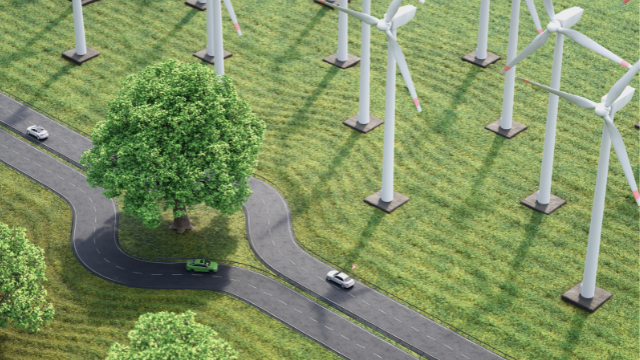Circular infrastructure: the key to decarbonisation
In Europe, it is estimated that the circular economy has added around 3.5 million jobs, around €126bn of economic value and mobilised private finance of around €15bn. Furthermore, it has been observed to empower lower income groups and support economic productivity. European Commission 2018 and Ellen MacArthur Foundation.
The G20 Infrastructure Working Group (IWG) has identified circular infrastructure as a key topic of their sustainable infrastructure agenda. Two key drivers for the G20 in relation to circular infrastructure include mitigating climate change and mitigating risk from resource scarcity. In terms of mitigating climate change, infrastructure is responsible for around 53% of the world’s greenhouse gas (GHG) emissions. Of this 53%, around 81% is attributed to operations of infrastructure and 19% is attributed to the embedded emissions from infrastructure – that is, the manufacturing, construction and lifecycle management of infrastructure assets. It is the embedded emission from infrastructure that can be addressed by circularity practices.
Given its share of GHG emissions, infrastructure needs to be decarbonised as part of the long-term transition to net zero and the limitation of global warming to 1.5%, as re-emphasised during the recent UN Climate Change Conference (COP26).
With these goals in mind, the GI Hub is working under the assumption that it may be nearly impossible to achieve significant progress in the decarbonisation of infrastructure without applying circular economy principles to all stages of asset lifecycles, including the development, design, construction, and operation of infrastructure projects. We are working to document and demonstrate this assumption, starting with a high-level analysis of embedded emissions from infrastructure. We need all infrastructure stakeholders to contribute, to indicate the opportunities of highest impact, where they stand with respect to these opportunities and what steps they are.
However, moving from a linear to a circular economy is not easy. It requires no less than a small revolution in the existing infrastructure procurement and delivery systems, and it involves everyone. This would likely entail a two-speed approach: (i) the deployment of ‘quick wins’ in the short term to help move the dial and (ii) longer-term change programs being developed and embedded across the infrastructure lifecycle.
What is circular infrastructure?
Circular infrastructure calls for the decoupling of infrastructure resources from urban and economic growth. This could mean several things, such as:
- using non-virgin materials, preferably renewable, in construction
- fabricating modular units for easier dismantling and recycling
- introducing infrastructure technologies (InfraTech) to optimise project implementation and monitoring of operations, minimise impact on ecosystems and resources, generate energy savings, and to reduce GHG emissions
- repurposing of infrastructure to supplement or replace the need for new infrastructure.
The circular infrastructure model is based on the 6R principles which work in circular loops to primarily rethink, refuse (or significantly reduce) the amount of raw materials entering the system. This is achieved by ‘closing the loop’ and maximising the amount of materials recovered and subsequently reused, repaired, refurbished and recycled to produce another product of equal or better quality than before. Residual materials are those that can no longer be reused or recycled, and the available pathways are to extract the embedded energy (e.g., through waste-to-energy) or to safely dispose of these.
Figure 1: Circular loops (6R Principles) within the construction value.

In 2021, the GI Hub was tasked with a G20 deliverable to examine the role that infrastructure can play in the transition to a circular economy.
The need for circular infrastructure
We currently live in what has been termed a ‘linear’ economy – where natural resources are extracted, turned into something of use, and then often discarded at the end of life. This linear model cannot be dissociated from our triple environmental crises: global warming and climate change; biodiversity loss and ecosystem damage; and pollution. The linear model is also resulting in enormous lost economic opportunities from failing to recapture the value of the materials and resources at end of use.
The infrastructure sector is the largest consumer of raw materials and energy globally, and also the largest contributor to the global waste stream by weight. Approximately half of all extracted raw resources globally are used to make construction materials[1]. The majority of embedded emissions are tied to steel (41%) and cement (48%) production. The sector is also extremely wasteful, with up to 40 per cent of urban solid waste coming from construction and demolition. The greatest impact associated with the construction sector is the ongoing need for virgin resource extraction.
The transition towards circular infrastructure opens new frameworks and business strategies for moving away from the linear take-make-waste economy, allowing the full value of our materials and resources to be captured during their usage and at end-of-life. For this transition to occur the infrastructure ecosystem needs to align with the following three underlying principles of a circular economy:
- Rethink the way we are doing things by designing out waste and pollution through upstream interventions
- Optimise our materials and resources by keeping our products and assets in use at the highest value possible throughout their lifetimes
- Regenerate our natural systems.
The circular economy also allows us to reach our net zero climate targets by achieving deeper GHG emission reductions, considering manufacturing processes and supply chain emissions (such as embodied carbon), as well as non-energy GHG emissions (such as land use changes). The importance of this is highlighted in a recent Canadian report by the National Zero Waste Council which found that 1.3 million tonnes of embodied carbon could be avoided per year if all buildings renovated or demolished in Canada were disassembled and reused.
What is the value of the circular economy for infrastructure?
The circular economy is about phasing out the concept of waste from products and services altogether and, in this case, our built environment. There are five well-established circular business strategies that look to capture the full value of resources. These are:
- Circular inputs – A business model which uses renewable energy, bio-based products (such as mass timber), or potentially completely recyclable materials (recycled plastics or concrete) as a key input (e.g. government procurements mandating/encouraging the use of recycled materials in the construction of roads)
- Sharing platforms– A business model which involves increasing the usage rates of assets through collaborative models for sharing and community access (e.g. ride sharing platforms optimising road infrastructure by increased usage of motor vehicles while reducing the need for parking infrastructure)
- Product-as-a-service– A business model where a product or assets ownership is retained by the producer over the long-term to increase its use, its number of users and hence, its productivity (e.g. road-as-a-service)
- Asset use extension– A business model focused on extending the lifetime of infrastructure assets through repair, maintenance, upgrading, and resale. This is currently being achieved through the digitalisation of infrastructure allowing the improved monitoring and as a result the optimisation of maintenance over the lifecycle of assets.
- Resource Recovery– A business model focused on the recovery of usable resources at the end of a product or asset’s life. Ensuring that government procurement process place greater emphasis on the end-of-life use of infrastructure .
These five business strategies clearly illustrate that circular infrastructure is much broader than caring for waste diversion and recycling. The intervention points span the entirety of both the value chain and the asset lifecycle. A circular infrastructure assets lifecycle starts with circular design, then product and material innovation and manufacturing (including offsite and modular construction), construction site best practices, asset use and operations (including long-term maintenance, repair, and adaptive reuse), and finally, deconstruction and resource recovery.
Current barriers
The market potential for circular infrastructure solutions is large and interest is growing. Increasingly, both private and public sector players are focusing on the design challenge of embedding circular infrastructure strategies into their practices and operations. However, much needs to be done regarding upstream circular initiatives, from government-led national strategies to product-as-a-service business strategies. Further, there are significant system barriers and existing inertia that must be overcome. Some of the key barriers include:
- Lack of awareness - Representatives from both public and private sectors report a knowledge gap about circular economy as it relates to infrastructure, as well as the data and information needed to make sound investment and policy decisions. There is also a lack of awareness around good / innovative practices and the outcomes from their implementation.
- A fragmented industry - Specialised suppliers often operate in silos across the value chain, creating barriers for the integration and systems approach required to advance circularity.
- Industry practice and cost challenges - Despite the contribution of public-private partnerships (PPPs) that have underscored the importance of building for the long-term, the construction sector has often been compared to the fast-fashion industry. A fast, cheap, and as a result, not very durable industry.
- Inconsistent policy and regulatory frameworks between jurisdictions - Creates challenges for businesses and investment risk. There is a need for a more coordinated approach internationally on definitions and standards for circular infrastructure to drive business as usual adoption of circularity principles.
Accelerating the circular infrastructure environment
It is essential that the business case and value proposition for circularity be clearly articulated for all stakeholders to incorporate circularity strategies and principles into their project development plans and portfolios. A focus on the key enablers can help to tackle the barriers, this includes:
- Increased exposure and awareness of the business strategies and opportunities, as well as better access to quality information and data that can inform business and policy decisions.
- Valuing circularity and embracing circular design, which means shifting to valuing durability, repairability, and adaptability and integrating circular design principles from the outset. A total cost of ownership model can help here.
- Supportive and harmonised policies and regulations are also essential to help drive the demand for circular products and services.
- Technology and business model innovation, including a focus on circular materials and leveraging digital technologies such as building information modelling (BIM), material passports and asset monitoring InfraTech applications.
- More cross-sector collaboration that can support the systems thinking and transformation required, which can include greater integration of circular principles within partnership models and existing practices, such as integrated design processes and integrated project delivery.
When it comes to how governments can help, interventions and policy mechanisms, such as comprehensive national action plans and roadmaps for the circular economy, are key to reducing risks associated with the adoption of circular economy solutions. For example, the European Union introduced a Circular Economy Action Plan as early as in 2015, which provided clarity and certainty for public and private infrastructure stakeholders to develop their respective models. The plan was updated in March 2020 and is one of the main building blocks of the European Green Deal, Europe’s new agenda for sustainable growth. In addition, the plan has led to initiatives as diverse as setting targets for resource recovery and enhancing asset monitoring technologies in the industrial sector. In the financing sector, the plan supported the introduction of blended financing and sustainability linked loans associated to the meeting of circular economy targets.
To conclude, the demand for circular solutions must increase across the entire value chain and where important decisions are being made. To advance the opportunities for circular infrastructure, systemic change and innovation will need to be deployed at a global scale.
Notes
| [1] |
The GI Hub’s analysis of the UNEP IRP data shows that the consumption of non-metallic materials for construction (e.g. sand, gravel and clay) comprised around 48% of global material consumption in 2018. |

 Infrastructure and Cicrular Economy
Infrastructure and Cicrular Economy





